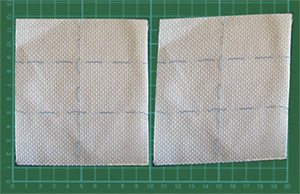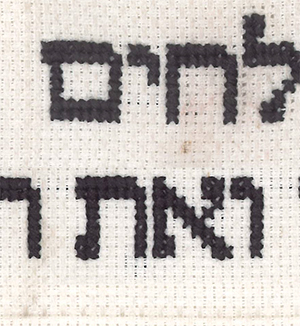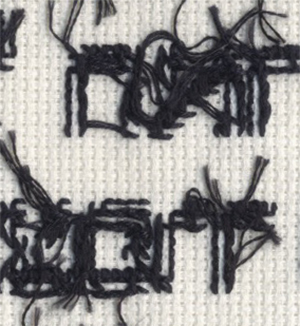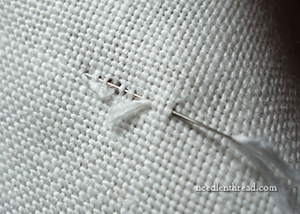Each panel received is a remarkable gift that attests to the commitment of its stitcher. Each panel also fulfills the primary goal of the project: “to engage with the words of Torah”. The spiritual and geographical diversity of participants are amazing. And it is especially heartening that so many people who have little or no prior experience with counted cross stitch have created outstanding pieces.
However, now that we are beginning to assemble the panels into columns, and then into the larger installation, we have identified issues that would not be significant problems if this were simply a personal project.
These issues fall into 3 categories:
➢ Timing
➢ Technical
➢ Troubling
We apologize that we are unable to answer inquiries about whether your panel will need adjustment or even be included in the exhibit until we are ready to assemble your verses. We outline these matters because we hope that stitchers still engaged in the process will take care, and those who think they may have erred will have the opportunity to purchase a new kit and stitch their verses again.
 Timing
Timing
Despite the fact that each stitcher signed a contract to complete the work within 6 months, approximately 30% of panels have not been returned within 7 months from the time the kits were sent. By 9 months 20% are still missing, and at least half of those stitchers have not communicated their problem despite at least two attempts by their coach to contact them.
Life happens; undertakings take longer than we anticipated; the task is daunting . . . we understand that, and empathize with your difficulties, some of which we are aware are life-threatening. We truly want to include all panels. But we require timely communication between stitchers and project team.
A volunteer coach will assigned to you 60-90 days after you receive your kit. If you need help sooner, email your request and we will be happy to assist. If you foresee a delay in completing your verses:
1. Contact your coach within 6 months of the date written at the top of your stitching guide.
2. Your coach will request a photo of what you have done so far and some particulars about why your progress is delayed. He/She will guide you.
3. You will receive an extension of up to 2 months. We really want you to have the joy of completing your panel in the way you envision it.
4. If you would like another stitcher to finish your panel:
(a) If you have completed fewer than 3 words, we will assign your verses to a new stitcher.
(b) If you have stitched 3 words or more we can arrange to have your work completed by one of the volunteers on our roster of “Eager Adopters“. We will send you the name and address of the adopter so that you can send your “orphan” directly to him/her. Please do not arrange a “private adoption” after the 6-month due date. Your name will still be listed in the catalogue as a stitcher.
Do not send your unfinished panel to Torah Stitch By Stitch unless requested.
Technical
The following are some of the technical problems we are seeing repeatedly, with suggestions of how to avoid or correct them before submitting your panel.
1. Rip in aida cloth
You will likely have to remove some of the stitches you have already done in order to clear the area for the repair. Do not use glue or tape or fusible fabric.
Method 1: patch
Cut a piece of fabric 1″ square. This can be aida cloth of the same count (#14) we are using or a piece of medium-weight cotton fabric. Position this behind the problem area and stitch through both layers for at least 5 stitches on all sides of the rip.
Method 2: darning
Pull a single thread of the canvas from the bottom edge and thread it onto a needle.
Starting about an inch away from the tear, right next to the torn canvas threads, stitch in the repair thread. Make sure that it follows the same over-under pattern as the broken thread. Stitch this thread in at least 1″ past the torn section in both directions.
2. Skewed or distorted cloth
Aida, like most woven fabric, is constructed so that the warp and weft threads intersect at right angles.
Skewing results from tight or uneven stitching tension that pulls the canvas threads on an angle or slant.
Avoid this by using a frame or hoop, or simply by easing the tension on your floss.
Most of the panels r eceived have a small amount of skew, which we can adjust. However, a difference of more than 1 cm or 0.5″ between the top and bottom of your canvas may not be correctable.
eceived have a small amount of skew, which we can adjust. However, a difference of more than 1 cm or 0.5″ between the top and bottom of your canvas may not be correctable.
3. Puckered cloth
Many of the panels received have a small amount of pucker, usually as a result of denser areas of stitching, such as borders and illuminations. A difference of more than .6 cm or 0.25″ between the worked and flat measurement of your canvas may not be correctable. Loosen your tension when completely filling lines and areas.
4. Text block too wide or irregular
The correct text block width is 168 stitches. We can accommodate panels with a variation of up to 2 stitches so long as the borders will fit within the 184 squares established as the assembly width.
5. Edges too narrow
We need at least 3 unstitched squares on each side of the 184 squares– including the overcast edges – to sew a seam. This applies also to upper and lower edges.
We became aware that some panels were not cut properly, and we will remediate that oversight.
6. Another brand of Aida cloth has been substituted
Zweigart 14-count cotton colour #264 (ivory) was carefully chosen. If you really feel you need to redo your panel, you need to purchase a piece of what we use from our distributor: needleworkersdelight.com/AidaCloth.html You can get an 18″ x 24″ section for under $10.
Troubling
These issues are not strictly technical, but will affect the overall character of the exhibition assembly.
1. Soiling
Over 20% of the panels are moderately to severely soiled. The conservators at the Textile Museum of Canada kindly offered some advice for dealing with minor problems. The effectiveness of these measures and the time we can spend are limited.
The Textile Museum conservators recommended prompt action: gentle spot cleaning with dilute dish detergent applied with a Q-tip, then thorough rinsing the same way and lots of padding below and above the spot to absorb moisture.
Do not immerse your canvas in water; that process alters its texture and dimensions.
The best strategy is to avoid soiling
o Tea (especially) and coffee are permanent dyes.
o Keep all food away from your stitching and work with clean hands.
o For guidelines or sketching use disappearing marker, basting stitches, or a paper pattern. Do not use pencil or ink
We will proceed to assemble panels with minor problems, but significant dirt or stains are not acceptable.
2. Embellishments deemed inappropriate
TSBS is an amazing achievement in “folk art”, and we respect each person’s creativity.
However we request that you not use:
o Your name or initials stitched on the front of your panel.
o Colours that stray significantly from the established palette.
o Materials (like beads) that will create unevenness when the assembly is rolled; or (like metalllic threads) that may not have stability and longevity.
3. Messy backsides
One picture is worth . . .
Remember to check the website often. The “Getting started” section contains a wealth of information and diagrams.



We do have some grubby places….what should we do with this?
Do enjoy the various blogs you put up…keeps us involved and part of this tremendous project.
The Textile Museum conservators recommended prompt action: gentle spot cleaning with dilute dish detergent applied with a Q-tip, then thorough rinsing the same way and lots of padding below and above the spot to absorb moisture.
Do not immerse your canvas in water; that process alters its texture and dimensions.
The best strategy is to avoid soiling
* Tea (especially) and coffee are permanent dyes.hairy backside
* Keep all food away from your stitching and work with clean hands.
How can a stitcher find out if the piece she/he submitted is usable?
The design of the exhibit is, indeed, magnificent and appropriate for a torah scroll.
The installation concept is breathtaking and the real thing will be even more so.
Kudos to all.
If my panel is not usable, would there be an opportunity to re-stitch the same verses and submit those for inclusion in the exhibition?
We sincerely want every stitcher’s work to be included in the assembly.
If there is a problem with yours, you will be contacted and offered the opportunity to redo it with a fresh kit. You are under no obligation to do so, but we hope you will decide to continue your participation.
The photo showing the back of the stitching looks a lot like mine. What can I do to make it neater?
A couple of suggestions for “cleaner backsides”:
* Do not carry threads more than 1″ between letters or words. Expert stitchers do not carry them at all;-)
* Never knot the thread at beginning or end. Stitch over the tail at the beginning; weave the end back in at least 4 stitches at the end.
* Clip these to about 1 cm.
Take a crochet hook and weave in ends , then clip the rest close.to work.
I grid my Aida cloth [with a running stitch] like the grid on the pattern. It makes it easier to follow. I have been quilting and doing all types of needle work for over 65 years. I do NOT recomend using the disappearing ink or any marking pens on a project as this . We do not know the effects of them on the fabrics long term. I hope this project will be in perfect condition.
The point of these guidelines is to ensure that the stitcher is overseeing the readiness of their verses. Ask yourself:
* Did I use the colours in the palette, or did I use what I wanted?
* Is the back very messy? Can you see threads travelling across the back, through the front?
* Have I ripped my canvas, and not done anything to repair it?
* Do I stitch when my hands are dirty? Is the canvas covered with food residue or marks?
I can’t imagine how frustrating it must be to receive a panel that was stitched so carelessly and then have to find someone else to do it. It would also be a bummer for the stitcher as well. It really isn’t rocket science, taking care of something 🙂
I have not seen on this site if it’s permissible to lightly steam iron the panel before I send it.
please advise.
Valuable info . . . I bookmarked it.
I would love to see my panel – Leviticus 26:10-13
The exhibit photos looks magnificent – Temma and team – Awesome task accomplished!!! Brava! Bravo!
So glad I did a tiny part of the whole. Hope to see my panel actually in the exhibit.
Marlene-
Thank you for your kind words and your participation.
We are currently assembling Leviticus. We hope to exhibit the remaining 50% of the Torah, but do not have a venue for that now. Perhaps you can help spread the word. Liking us on social media creates buzz.